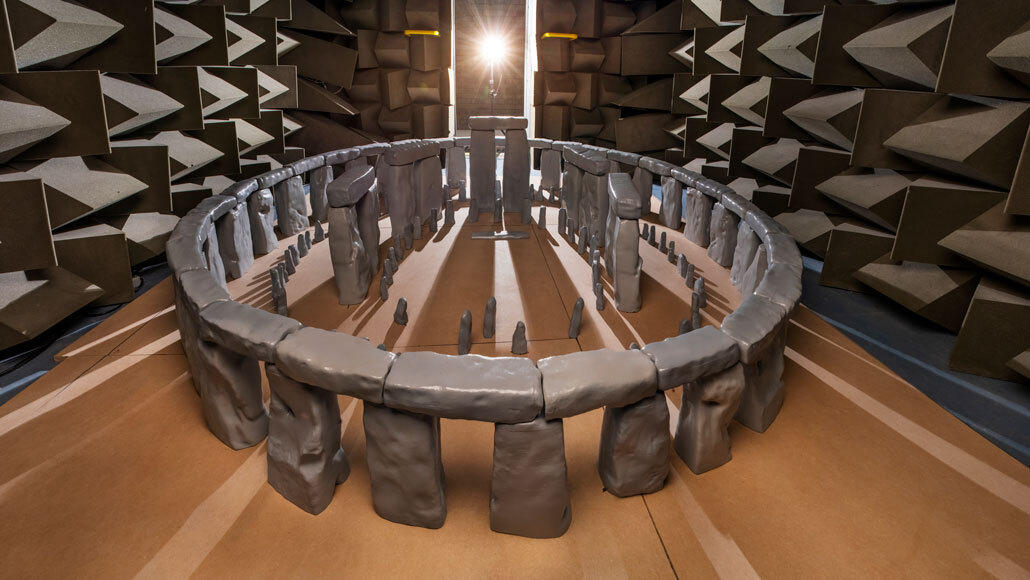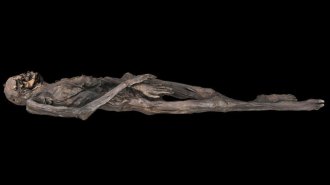Stonehenge enhanced sounds like voices or music for people inside the monument
Scientists created a scale model one-twelfth the size of the ancient site to study its acoustics

Acoustic research using a scale model one-twelfth the size of Stonehenge (above) finds that the completed monument would have magnified speech and improved musical sounds, but only for those inside the stone circle.
Acoustics Research Centre/Univ. of Salford
By Bruce Bower
- More than 2 years ago
Read another version of this article at Science News Explores
Welcome to Soundhenge. Better known as Stonehenge, this ancient monument in southern England created an acoustic space that amplified voices and improved the sound of any music being played for people standing within the massive circle of stones, a new study suggests.
Because of how stones were placed, that speech or music would not have projected beyond Stonehenge into the surrounding countryside, or even to people standing near the stone circle, scientists report in the October Journal of Archaeological Science.
To explore Stonehenge’s sound dynamics, acoustical engineer Trevor Cox and colleagues used laser scans of the site and archaeological evidence to construct a physical model one-twelfth the size of the actual monument. That was the largest possible scale replica that could fit inside an acoustic chamber at the University of Salford in England, where Cox works. This room simulated the acoustic effects of the open landscape surrounding Stonehenge and compacted ground inside the monument.
Stonehenge Lego, as Cox dubbed the model, was assembled assuming that Stonehenge’s outer circle of standing sarsen stones — a type of silcrete rock found in southern England — had originally consisted of 30 stones. Stonehenge today includes 63 complete stones, including 17 standing sarsen stones in the outer circle. Based on an estimated total of 157 stones placed at the site around 4,200 years ago, the researchers 3-D printed 27 stones of all sizes and shapes. Then, the team used silicone molds of those items and plaster mixed with other materials to re-create the remaining 130 stones. Simulated stones were constructed to minimize sound absorption, much like actual stones at Stonehenge, Cox says.

Finally, the team placed speakers and microphones at various points inside and just outside Stonehenge Lego. Each speaker emitted chirping sounds that swept from low to high frequencies. Sound frequencies were modulated so that the speakers’ sounds interacted with the model stones much as natural sounds behave at actual Stonehenge.
Despite many gaps between stones, sounds briefly lingered inside Stonehenge Lego, the team found. Reverberation time, a measure of the time it takes sound to decay by 60 decibels, averaged about 0.6 seconds inside the model for mid-frequency sounds. That effect would have boosted the ability to hear voices and enhanced sounds of drums or other musical instruments, Cox says. For comparison, reverberation time reaches about 0.4 seconds in a living room, around two seconds in a large concert hall and roughly eight seconds in a large cathedral.
Stonehenge Lego did not project sounds into the surrounding area or boost the quality of sounds coming from external speakers. And sounds did not echo in the scale model. Inner groups of simulated stones obscured and scattered sounds reflected off the outer sarsen circle, blocking echo formation.
Sign up for our newsletter
We summarize the week's scientific breakthroughs every Thursday.
Previous research has been done on Stonehenge’s acoustics, but was incomplete, says archaeologist Timothy Darvill of Bournemouth University in England who has excavated at Stonehenge but did not participate in the new research. That work includes sound measurements taken at what remains of Stonehenge today and at a Stonehenge replica in Washington state made of concrete blocks. Another acoustic study employed a computer model of the ancient site.
Although the new study was “carefully and rigorously done,” questions remain about sonic effects at Stonehenge, says musicologist Rupert Till of the University of Huddersfield in England, who conducted some of the previous research. A wider range of acoustic measures is needed, for instance, to detect echo effects in the scale model that are also present at Stonehenge, Till argues. Further research also needs to untangle why “Stonehenge hums when the wind blows hard,” he says.
It’s not known what, if any, ceremonies or activities occurred at Stonehenge, though the site did serve as a cemetery between around 5,000 and 4,400 years ago (SN: 8/2/18). And Cox cautions that designers of Stonehenge were likely less concerned about acoustics than about issues such as treatment of the dead and astronomical alignments.
Whatever people once did at Stonehenge, the new study “shows that sound was fairly well contained within the monument and, by implication, [Stonehenge] was fairly well insulated from sounds coming in,” Darvill says. Hearing sounds of some kind circulating inside the ancient monument “must have been one of the fundamental experiences of Stonehenge.”







